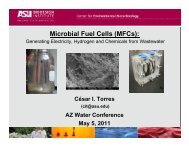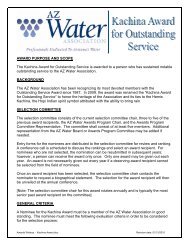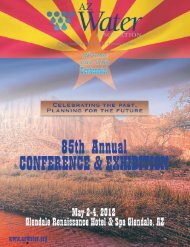Request For Sale (Rfs 08-07) - AZ Water Association
Request For Sale (Rfs 08-07) - AZ Water Association
Request For Sale (Rfs 08-07) - AZ Water Association
Create successful ePaper yourself
Turn your PDF publications into a flip-book with our unique Google optimized e-Paper software.
HISTORIAN / Report continued from page 23<br />
7 mi. of it above ground … the Aqua<br />
Marcia Aqueduct. In 300 AD, Rome’s<br />
system of aqueducts was delivering water<br />
into the City at the rate of 300 gal/capita/<br />
day. The Roman Empire fell in 375 AD.<br />
Machu Picchu: Incan engineers constructed<br />
water distribution systems/fountains –<br />
1450 AD. Many of the channels still<br />
carry water.<br />
Dark Ages (approx. 450 AD – 1500 AD): Little<br />
development in water systems (sources,<br />
distribution or treatment) development;<br />
instead, the people’s main concern was<br />
“basic survival”.<br />
Revitalization of Efforts to Clean <strong>Water</strong>: Sir Robert<br />
Bacon began experimenting with a form<br />
of sand filtration to remove salt from sea<br />
water. Although his efforts were not<br />
successful, his work sparked a revival of<br />
experimentation in water treatment –<br />
1627 AD.<br />
Age of Enlightenment (16th through 18th centuries):<br />
Philosophers discussed the natural rights<br />
of all humanity. French scientists<br />
(approx. 1550) proposed that every<br />
French household install a sand filter to<br />
provide them with clean water. 100 years<br />
later, government officials in the United<br />
Kingdom noted that every home in the<br />
kingdom should be provided with<br />
filtered water.<br />
Microscope: Zaccharias Jannsen (and his<br />
son, Hans) experimented (1590 AD)<br />
with glass lens in a tube – to magnify<br />
objects; their work was the forerunner of<br />
the modern day telescopes and<br />
microscopes. Approximately100 years<br />
later (1690 AD), Anton van<br />
Leeuwenhoek improved upon Jannsen’s<br />
work and was able to reach<br />
magnifications of up to 270 times that of<br />
the original object’s size. Leeuwenhoek<br />
was the first person noted to have<br />
actually seen microorganisms in water –<br />
using his microscope.<br />
<strong>AZ</strong> WATER ASSOCIATION 24 January 2009<br />
First US <strong>Water</strong>works: <strong>For</strong>med in 1652 in<br />
Boston, MA to distribute water (via wood<br />
log pipe) for fire fighting and domestic<br />
use; incorporated over 15 mi. of wood<br />
(hemlock) log water pipe (3” and 5” ID).<br />
First Use of Cast Iron Pipe: Gardens of<br />
Versailles, France. Installed in mid –<br />
1700’s; stayed in service until early<br />
1920’s. Philadelphia, PA was the first US<br />
city to use cast iron pipe for water<br />
distribution – 1804.<br />
First Treated Drinking <strong>Water</strong> Supply for an Entire City:<br />
Paisley, Scotland in 1804. Paisley’s system<br />
utilized slow sand filters for treatment –<br />
designed by Robert Thom, a scientist of<br />
the Scottish Enlightenment.<br />
Paris, France’s <strong>Water</strong> Treatment Plant: Paris’ water<br />
plant allowed the water to set under<br />
quiescent conditions (to help settle out<br />
particulate matter) for 12 hours before<br />
being filtered through beds of sand and<br />
charcoal (filter media had to be changed<br />
out every 6 hours) – early 1800’s.<br />
England - First (Slow) Sand Filters: Developed by<br />
Englishman James Simpson and<br />
patterned somewhat after Robert Thom’s<br />
design – 1827; many historians consider<br />
Simpson’s achievements to be one of the<br />
most significant advances in Public<br />
Health history.<br />
Crotan Aqueduct: Constructed to bring water<br />
in to New York City – comprised of a 41<br />
mi. long system of open channels, 16<br />
tunnels, 114 culverts and a bridge over<br />
the Harlem River – 1850’s.<br />
Progress: Cholera was proven by Dr. John<br />
Snow (England), utilizing a microscope, to<br />
be a water bourne disease; realized by<br />
linking the source of an outbreak of illness<br />
in London to a public well (Broad Street)<br />
that had been contaminated with sewage –<br />
1855. The Broad Street Pump had a<br />
reputation for its water having good taste<br />
and quality. Snow’s discovery proved again<br />
that taste and visual clarity does not<br />
necessarily always mean the involved water<br />
is pure. The English soon began utilizing<br />
chlorine to disinfect water supplies.<br />
<strong>Water</strong> Tunnels (Chicago, IL): <strong>Water</strong> was brought<br />
into City of Chicago from Lake Michigan<br />
via a twin tunnel system (2 mi. long).<br />
The first tunnel was completed in 1869<br />
and utilized a 3’ wide, 138’ tall standpipe<br />
(to equalize pressure in the mains in the<br />
City). The building that housed the<br />
standpipe (Chicago <strong>Water</strong> Tower), up<br />
until 1906, was spared from the great<br />
Chicago Fire of 1871 and stands yet<br />
today. Initially, coal fired steam engines<br />
powered the pumps that drew water<br />
from the tunnels for distribution<br />
into/through the water mains of the City.<br />
Louis Pasteur: Through his “germ theory”;<br />
he was able to illustrate how microscopic<br />
organisms could transmit disease through<br />
media such as water – 1880’s.<br />
Rapid Sand Filters: Thom’s and Simpson’s<br />
slow sand filters worked but, they were<br />
large and required frequent/extensive<br />
cleaning. The growing need for clean<br />
water caused the design (in the US) of<br />
rapid sand filters – ones cleaned by<br />
powerful streams of water; as such,<br />
bettering the filter’s efficiencies and<br />
capacities - late 1800’s, early 1900’s.<br />
Early <strong>Water</strong> Treatment Facilities in the United States<br />
(Early 1900’s): Emerging knowledge<br />
indicated that the ability of water to<br />
convey pathogens was directly related to<br />
the level of turbidity present. As such,<br />
most of the early treatment systems in<br />
the US worked to lower the water’s level<br />
of turbidity – thereby also removing<br />
disease causing microbes; ones that<br />
caused typhoid, dysentery and cholera.<br />
Slow sand filtration was the process used<br />
early on; followed shortly by the use of<br />
rapid sand filters. The use of rapid sand<br />
filters; and, soon thereafter, combined<br />
with the use of chlorine as a disinfectant,

















